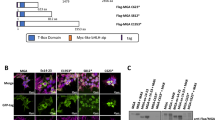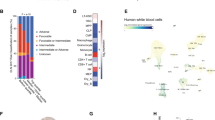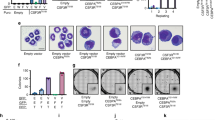Abstract
Through a targeted knockdown (KD) screen of chromatin regulatory genes, we identified the EP400 complex components EPC1 and EPC2 as critical oncogenic cofactors in acute myeloid leukemia (AML). EPC1 and EPC2 were required for the clonogenic potential of human AML cells of multiple molecular subtypes. Focusing on MLL-mutated AML as an exemplar, Epc1 or Epc2 KD-induced apoptosis of murine MLL-AF9 AML cells and abolished leukemia stem cell potential. By contrast, normal hematopoietic stem and progenitor cells (HSPC) were spared. Similar selectivity was observed for human primary AML cells versus normal CD34+ HSPC. In keeping with these distinct functional consequences, Epc1 or Epc2 KD-induced divergent transcriptional consequences in murine MLL-AF9 granulocyte-macrophage progenitor-like (GMP) cells versus normal GMP, with a signature of increased MYC activity in leukemic but not normal cells. This was caused by accumulation of MYC protein and was also observed following KD of other EP400 complex genes. Pharmacological inhibition of MYC:MAX dimerization, or concomitant MYC KD, reduced apoptosis following EPC1 KD, linking the accumulation of MYC to cell death. Therefore, EPC1 and EPC2 are components of a complex that directly or indirectly serves to prevent MYC accumulation and AML cell apoptosis, thus sustaining oncogenic potential.
This is a preview of subscription content, access via your institution
Access options
Subscribe to this journal
Receive 12 print issues and online access
$259.00 per year
only $21.58 per issue
Buy this article
- Purchase on Springer Link
- Instant access to full article PDF
Prices may be subject to local taxes which are calculated during checkout







Similar content being viewed by others
Accession codes
References
The Cancer Genome Atlas Research Network. Genomic and epigenomic landscapes of adult de novo acute myeloid leukemia. N Engl J Med 2013; 368: 2059–2074.
de Boer J, Walf-Vorderwulbecke V, Williams O . In focus: MLL-rearranged leukemia. Leukemia 2013; 27: 1224–1228.
Figueroa ME, Lugthart S, Li Y, Erpelinck-Verschueren C, Deng X, Christos PJ et al. DNA methylation signatures identify biologically distinct subtypes in acute myeloid leukemia. Cancer Cell 2010; 17: 13–27.
Figueroa ME, Skrabanek L, Li Y, Jiemjit A, Fandy TE, Paietta E et al. MDS and secondary AML display unique patterns and abundance of aberrant DNA methylation. Blood 2009; 114: 3448–3458.
Schoofs T, Berdel WE, Muller-Tidow C . Origins of aberrant DNA methylation in acute myeloid leukemia. Leukemia 2014; 28: 1–14.
Fenaux P, Mufti GJ, Hellstrom-Lindberg E, Santini V, Finelli C, Giagounidis A et al. Efficacy of azacitidine compared with that of conventional care regimens in the treatment of higher-risk myelodysplastic syndromes: a randomised, open-label, phase III study. Lancet Oncol 2009; 10: 223–232.
Estey EH . Epigenetics in clinical practice: the examples of azacitidine and decitabine in myelodysplasia and acute myeloid leukemia. Leukemia 2013; 27: 1803–1812.
Burnett AK, Hills RK, Milligan DW, Goldstone AH, Prentice AG, McMullin MF et al. Attempts to optimize induction and consolidation treatment in acute myeloid leukemia: results of the MRC AML12 trial. J Clin Oncol 2010; 28: 586–595.
Wiseman DH, Greystoke BF, Somervaille TC . The variety of leukemic stem cells in myeloid malignancy. Oncogene 2013; e-pub ahead of print 8 July 2013 doi:10.1038/onc.2013.269.
Daigle SR, Olhava EJ, Therkelsen CA, Majer CR, Sneeringer CJ, Song J et al. Selective killing of mixed lineage leukemia cells by a potent small-molecule DOT1L inhibitor. Cancer Cell 2011; 20: 53–65.
Harris WJ, Huang X, Lynch JT, Spencer GJ, Hitchin JR, Li Y et al. The histone demethylase KDM1A sustains the oncogenic potential of MLL-AF9 leukemia stem cells. Cancer Cell 2012; 21: 473–487.
Zuber J, Shi J, Wang E, Rappaport AR, Herrmann H, Sison EA et al. RNAi screen identifies Brd4 as a therapeutic target in acute myeloid leukaemia. Nature 2011; 478: 524–528.
Dawson MA, Prinjha RK, Dittmann A, Giotopoulos G, Bantscheff M, Chan WI et al. Inhibition of BET recruitment to chromatin as an effective treatment for MLL-fusion leukaemia. Nature 2011; 478: 529–533.
Balgobind BV, Zwaan CM, Pieters R, Van den Heuvel-Eibrink MM . The heterogeneity of pediatric MLL-rearranged acute myeloid leukemia. Leukemia 2011; 25: 1239–1248.
Meyer C, Hofmann J, Burmeister T, Groger D, Park TS, Emerenciano M et al. The MLL recombinome of acute leukemias in 2013. Leukemia 2013; 27: 2165–2176.
Shi J, Wang E, Zuber J, Rappaport A, Taylor M, Johns C et al. The Polycomb complex PRC2 supports aberrant self-renewal in a mouse model of MLL-AF9;Nras(G12D) acute myeloid leukemia. Oncogene 2013; 32: 930–938.
Somervaille TC, Cleary ML . Identification and characterization of leukemia stem cells in murine MLL-AF9 acute myeloid leukemia. Cancer Cell 2006; 10: 257–268.
Somervaille TC, Matheny CJ, Spencer GJ, Iwasaki M, Rinn JL, Witten DM et al. Hierarchical maintenance of MLL myeloid leukemia stem cells employs a transcriptional program shared with embryonic rather than adult stem cells. Cell Stem Cell 2009; 4: 129–140.
Subramanian A, Tamayo P, Mootha VK, Mukherjee S, Ebert BL, Gillette MA et al. Gene set enrichment analysis: a knowledge-based approach for interpreting genome-wide expression profiles. Proc Natl Acad Sci USA 2005; 102: 15545–15550.
Yokoyama A, Somervaille TC, Smith KS, Rozenblatt-Rosen O, Meyerson M, Cleary ML . The menin tumor suppressor protein is an essential oncogenic cofactor for MLL-associated leukemogenesis. Cell 2005; 123: 207–218.
Sato T, Russell MA, Denell RE . Homoeosis in Drosophila: a new enhancer of polycomb and related homoeotic mutations. Genetics 1983; 105: 357–370.
Stankunas K, Berger J, Ruse C, Sinclair DA, Randazzo F, Brock HW . The enhancer of polycomb gene of Drosophila encodes a chromatin protein conserved in yeast and mammals. Development 1998; 125: 4055–4066.
Boudreault AA, Cronier D, Selleck W, Lacoste N, Utley RT, Allard S et al. Yeast enhancer of polycomb defines global Esa1-dependent acetylation of chromatin. Genes Dev 2003; 17: 1415–1428.
Doyon Y, Selleck W, Lane WS, Tan S, Cote J . Structural and functional conservation of the NuA4 histone acetyltransferase complex from yeast to humans. Mol Cell Biol 2004; 24: 1884–1896.
Kim JR, Kee HJ, Kim JY, Joung H, Nam KI, Eom GH et al. Enhancer of polycomb1 acts on serum response factor to regulate skeletal muscle differentiation. J Biol Chem 2009; 284: 16308–16316.
Fuchs M, Gerber J, Drapkin R, Sif S, Ikura T, Ogryzko V et al. The p400 complex is an essential E1A transformation target. Cell 2001; 106: 297–307.
Kim J, Woo AJ, Chu J, Snow JW, Fujiwara Y, Kim CG et al. A Myc network accounts for similarities between embryonic stem and cancer cell transcription programs. Cell 2010; 143: 313–324.
Lin CY, Loven J, Rahl PB, Paranal RM, Burge CB, Bradner JE et al. Transcriptional amplification in tumor cells with elevated c-Myc. Cell 2012; 151: 56–67.
Nie Z, Hu G, Wei G, Cui K, Yamane A, Resch W et al. c-Myc is a universal amplifier of expressed genes in lymphocytes and embryonic stem cells. Cell 2012; 151: 68–79.
Sears R, Leone G, DeGregori J, Nevins JR . Ras enhances Myc protein stability. Mol Cell 1999; 3: 169–179.
Yin X, Giap C, Lazo JS, Prochownik EV . Low molecular weight inhibitors of Myc-Max interaction and function. Oncogene 2003; 22: 6151–6159.
Huang MJ, Cheng YC, Liu CR, Lin S, Liu HE . A small-molecule c-Myc inhibitor, 10058-F4, induces cell-cycle arrest, apoptosis, and myeloid differentiation of human acute myeloid leukemia. Exp Hematol 2006; 34: 1480–1489.
Chittuluru JR, Chaban Y, Monnet-Saksouk J, Carrozza MJ, Sapountzi V, Selleck W et al. Structure and nucleosome interaction of the yeast NuA4 and Piccolo-NuA4 histone acetyltransferase complexes. Nat Struct Mol Biol 2011; 18: 1196–1203.
Sinclair DA, Clegg NJ, Antonchuk J, Milne TA, Stankunas K, Ruse C et al. Enhancer of Polycomb is a suppressor of position-effect variegation in Drosophila melanogaster. Genetics 1998; 148: 211–220.
Micci F, Panagopoulos I, Bjerkehagen B, Heim S . Consistent rearrangement of chromosomal band 6p21 with generation of fusion genes JAZF1/PHF1 and EPC1/PHF1 in endometrial stromal sarcoma. Cancer Res 2006; 66: 107–112.
Nakahata S, Saito Y, Hamasaki M, Hidaka T, Arai Y, Taki T et al. Alteration of enhancer of polycomb 1 at 10p11.2 is one of the genetic events leading to development of adult T-cell leukemia/lymphoma. Genes Chromosomes Cancer 2009; 48: 768–776.
Squatrito M, Gorrini C, Amati B . Tip60 in DNA damage response and growth control: many tricks in one HAT. Trends Cell Biol 2006; 16: 433–442.
McMahon SB, Van Buskirk HA, Dugan KA, Copeland TD, Cole MD . The novel ATM-related protein TRRAP is an essential cofactor for the c-Myc and E2F oncoproteins. Cell 1998; 94: 363–374.
Wood MA, McMahon SB, Cole MD . An ATPase/helicase complex is an essential cofactor for oncogenic transformation by c-Myc. Mol Cell 2000; 5: 321–330.
Attwooll C, Oddi S, Cartwright P, Prosperini E, Agger K, Steensgaard P et al. A novel repressive E2F6 complex containing the polycomb group protein, EPC1, that interacts with EZH2 in a proliferation-specific manner. J Biol Chem 2005; 280: 1199–1208.
Osaki H, Walf-Vorderwulbecke V, Mangolini M, Zhao L, Horton SJ, Morrone G et al. The AAA ATPase RUVBL2 is a critical mediator of MLL-AF9 oncogenesis. Leukemia 2013.
Soucek L, Evan GI . The ups and downs of Myc biology. Curr Opin Genet Dev 2010; 20: 91–95.
Murphy DJ, Junttila MR, Pouyet L, Karnezis A, Shchors K, Bui DA et al. Distinct thresholds govern Myc’s biological output in vivo. Cancer Cell 2008; 14: 447–457.
Pelengaris S, Khan M, Evan GI . Suppression of Myc-induced apoptosis in beta cells exposes multiple oncogenic properties of Myc and triggers carcinogenic progression. Cell 2002; 109: 321–334.
Evan GI, Wyllie AH, Gilbert CS, Littlewood TD, Land H, Brooks M et al. Induction of apoptosis in fibroblasts by c-myc protein. Cell 1992; 69: 119–128.
Thomas LR, Tansey WP . Proteolytic control of the oncoprotein transcription factor Myc. Adv Cancer Res 2011; 110: 77–106.
Luscher B, Vervoorts J . Regulation of gene transcription by the oncoprotein MYC. Gene 2012; 494: 145–160.
Malempati S, Tibbitts D, Cunningham M, Akkari Y, Olson S, Fan G et al. Aberrant stabilization of c-Myc protein in some lymphoblastic leukemias. Leukemia 2006; 20: 1572–1581.
Hemann MT, Bric A, Teruya-Feldstein J, Herbst A, Nilsson JA, Cordon-Cardo C et al. Evasion of the p53 tumour surveillance network by tumour-derived MYC mutants. Nature 2005; 436: 807–811.
King B, Trimarchi T, Reavie L, Xu L, Mullenders J, Ntziachristos P et al. The ubiquitin ligase FBXW7 modulates leukemia-initiating cell activity by regulating MYC stability. Cell 2013; 153: 1552–1566.
Vervoorts J, Luscher-Firzlaff JM, Rottmann S, Lilischkis R, Walsemann G, Dohmann K et al. Stimulation of c-MYC transcriptional activity and acetylation by recruitment of the cofactor CBP. EMBO Rep 2003; 4: 484–490.
Faiola F, Liu X, Lo S, Pan S, Zhang K, Lymar E et al. Dual regulation of c-Myc by p300 via acetylation-dependent control of Myc protein turnover and coactivation of Myc-induced transcription. Mol Cell Biol 2005; 25: 10220–10234.
Patel JH, Du Y, Ard PG, Phillips C, Carella B, Chen CJ et al. The c-MYC oncoprotein is a substrate of the acetyltransferases hGCN5/PCAF and TIP60. Mol Cell Biol 2004; 24: 10826–10834.
Lynch JT, Somerville TD, Spencer GJ, Huang X, Somervaille TC . TTC5 is required to prevent apoptosis of acute myeloid leukemia stem cells. Cell Death Dis 2013; 4: e573.
Forbes SA, Bindal N, Bamford S, Cole C, Kok CY, Beare D et al. COSMIC: mining complete cancer genomes in the Catalogue of Somatic Mutations in Cancer. Nucleic Acids Res 2011; 39 (Database issue): D945–D950.
Acknowledgements
We thank Jodie Whitaker, Gillian Newton, Morgan Blaylock, Jeff Barry, Michael Hughes, Gail Bruder, Angela Cooke and Deepti Wilks for technical support; William Harris for assistance with plasmid preparations; Chris Womack and staff at the Clinical Pharmacology Unit at Astra Zeneca, Alderley Park, UK for access to normal subjects for BM collection; and Georges Lacaud, Nullin Divecha and Valerie Kouskoff for a critical reading of the manuscript. This work was supported by Cancer Research UK grant number C5759/A12328.
Author information
Authors and Affiliations
Corresponding author
Ethics declarations
Competing interests
The authors declare no conflict of interest.
Additional information
Supplementary Information accompanies this paper on the Leukemia website
Supplementary information
Rights and permissions
About this article
Cite this article
Huang, X., Spencer, G., Lynch, J. et al. Enhancers of Polycomb EPC1 and EPC2 sustain the oncogenic potential of MLL leukemia stem cells. Leukemia 28, 1081–1091 (2014). https://doi.org/10.1038/leu.2013.316
Received:
Revised:
Accepted:
Published:
Issue Date:
DOI: https://doi.org/10.1038/leu.2013.316
Keywords
This article is cited by
-
Unconventional roles of chromatin remodelers and long non-coding RNAs in cell division
Cellular and Molecular Life Sciences (2023)
-
A KDM4A-PAF1-mediated epigenomic network is essential for acute myeloid leukemia cell self-renewal and survival
Cell Death & Disease (2021)
-
Fusion genes in gynecologic tumors: the occurrence, molecular mechanism and prospect for therapy
Cell Death & Disease (2021)
-
RNA isoform screens uncover the essentiality and tumor-suppressor activity of ultraconserved poison exons
Nature Genetics (2020)
-
Critical genomic regulation mediated by Enhancer of Polycomb
Current Genetics (2018)



